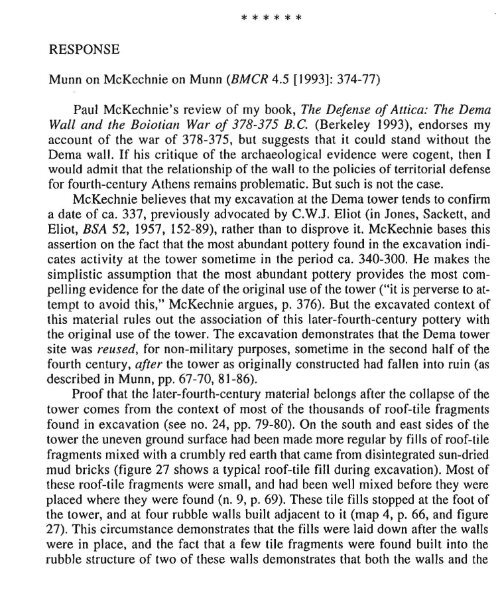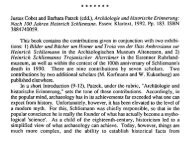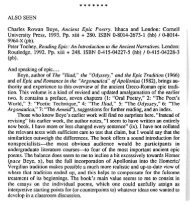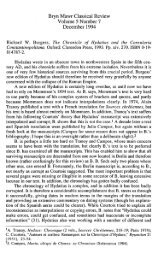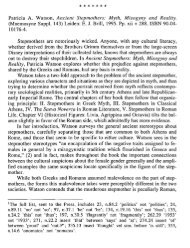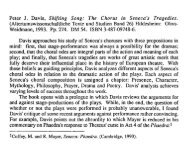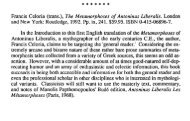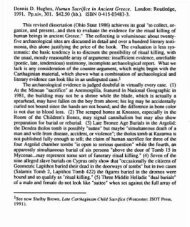94.4, Response, Munn on McKechnie on Munn - Bryn Mawr ...
94.4, Response, Munn on McKechnie on Munn - Bryn Mawr ...
94.4, Response, Munn on McKechnie on Munn - Bryn Mawr ...
Create successful ePaper yourself
Turn your PDF publications into a flip-book with our unique Google optimized e-Paper software.
RESPONSE<br />
* * * * * *<br />
<str<strong>on</strong>g>Munn</str<strong>on</strong>g> <strong>on</strong> <strong>McKechnie</strong> <strong>on</strong> <str<strong>on</strong>g>Munn</str<strong>on</strong>g> (BMCR 4.5 [1993]: 374-77)<br />
Paul <strong>McKechnie</strong>'s review of my book, The Defense of Attica: The Dema<br />
Wall and the Boiotiall War of 378-375 B.c. (Berkeley 1993), endorses my<br />
account of the war of 378-375, but suggests that it could stand without the<br />
Dema wall. If his critique of the archaeological evidence were cogent, then I<br />
would admit that the relati<strong>on</strong>ship of the wall to the policies of territorial defense<br />
for fourth-century Athens remains problematic. But such is not the case.<br />
<strong>McKechnie</strong> believes that my excavati<strong>on</strong> at the Dema tower tends to c<strong>on</strong>firm<br />
a date of ca. 337, previously advocated by C.W.J. Eliot (in J<strong>on</strong>es, Sackett, and<br />
Eliot, BSA 52, 1957, 152-89), rather than to disprove it. <strong>McKechnie</strong> bases this<br />
asserti<strong>on</strong> <strong>on</strong> the fact that the most abundant pottery found in the excavati<strong>on</strong> indicates<br />
activity at the tower sometime in the period ca. 340-300. He makes the<br />
simplistic assumpti<strong>on</strong> that the most abundant pottery provides the most compelling<br />
evidence for the date of the original use of the tower ("it is perverse to attempt<br />
to avoid this," <strong>McKechnie</strong> argues, p. 376). But the excavated c<strong>on</strong>text of<br />
this material rules out the associati<strong>on</strong> of this later-fourth-century pottery with<br />
the original use of the tower. The excavati<strong>on</strong> dem<strong>on</strong>strates that the Dema tower<br />
site was reused, for n<strong>on</strong>-military purposes, sometime in the sec<strong>on</strong>d half of the<br />
fourth century, after the tower as originally c<strong>on</strong>structed had fallen into ruin (as<br />
described in <str<strong>on</strong>g>Munn</str<strong>on</strong>g>, pp. 67-70, 81-86).<br />
Proof that the later-fourth-century material bel<strong>on</strong>gs after the collapse of the<br />
tower comes from the c<strong>on</strong>text of most of the thousands of roof-tile fragments<br />
found in excavati<strong>on</strong> (see no. 24, pp. 79-80). On the south and east sides of the<br />
tower the uneven ground surface had been made more regular by fills of roof-tile<br />
fragments mixed with a crumbly red earth that came from disintegrated sun-dried<br />
mud bricks (figure 27 shows a typical roof-tile fill during excavati<strong>on</strong>). Most of<br />
these roof-tile fragments were small, and had been well mixed before they were<br />
placed where they were found (n. 9, p. 69). These tile fills stopped at the foot of<br />
the tower, and at four rubble walls built adjacent to it (map 4, p. 66, and figure<br />
27). This circumstance dem<strong>on</strong>strates that the fills were laid down after the walls<br />
were in place, and the fact that a few tile fragments were found built into the<br />
rubble structure of two of these walls dem<strong>on</strong>strates that both the walls and the
<strong>Bryn</strong> <strong>Mawr</strong> Classical Review 5.4 (1994) 363<br />
fills were put in place when large quantities of broken roof tiles were available<br />
<strong>on</strong> the site (as described <strong>on</strong> pp. 69-70, and n. IS, p. 81). The tiles could <strong>on</strong>ly<br />
have come from the original roof of the tower, and the disintegrated mud brick<br />
from its walls, after the collapse of the tower.<br />
Numerous sherds (137 individual fragments are recorded) coming from at<br />
least thirteen different ceramic vessels datable to the sec<strong>on</strong>d half of the fourth<br />
century were found <strong>on</strong> top of or nearby these roof-tile fills; n<strong>on</strong>e was found under<br />
the tile fills (see nn. 6 and 8, p. 68). Am<strong>on</strong>g these, fragments of a small vessel,<br />
an aryballos (no. 6, pp. 73-74), were found together in <strong>on</strong>e spot atop <strong>on</strong>e of<br />
these roof-tile fills, where it evidently had been broken and aband<strong>on</strong>ed. The<br />
undispersed nature of these fragments c<strong>on</strong>trasts sharply with the c<strong>on</strong>siderable<br />
mixing underg<strong>on</strong>e by the roof-tile fragments under them. This vessel had to have<br />
been broken where it was found after the tile fill was in place, and therefore after<br />
the tower had collapsed. Single or multiple sherds, many of the latter<br />
undispersed, of at least twelve more vessels and two ceramic beehive lids (nos. 3<br />
5, 7, 8, 12-20, pp. 73-78) likewise indicate that this reuse of the site came to an<br />
end sometime within the period ca. 340-300. The date for the tower's original<br />
use is indicated by the five sherds from two cups (nos. 1 and 2, pp. 71-73),<br />
whose use most likely bel<strong>on</strong>gs within the range ca. 425-375 (as discussed <strong>on</strong> pp.<br />
82-84, 86, 90-91, and 124).<br />
<strong>McKechnie</strong>'s critique of my explanati<strong>on</strong> of the Dema tower has nothing to<br />
say about the significance of the c<strong>on</strong>texts and relati<strong>on</strong>ships revealed in excavati<strong>on</strong>.<br />
Instead, he challenges the plausibility of the corollary of my dem<strong>on</strong>strati<strong>on</strong>,<br />
namely, that the ruins of the tower were used specifically as an apiary. This<br />
c<strong>on</strong>clusi<strong>on</strong> follows simply from the discovery of numerous ceramic beehive<br />
fragments throughout the excavati<strong>on</strong> (nos. 18-20 pp. 77-78). Given the prevalence<br />
of beehive fragments at rural Attic sites, and the testim<strong>on</strong>ies to beekeeping<br />
in the area of the Dema wall in the nineteenth and twentieth centuries (as discussed<br />
<strong>on</strong> pp. 84-86), there is nothing implausible about this practical reuse of<br />
the debris of the Dema tower. Reuse at this time is all the more plausible when<br />
we recall that the ruins of the nearby Dema house were also partially reused at<br />
this time (as discussed <strong>on</strong> pp. 44-46, and n. 15). <strong>McKechnie</strong> has no comment <strong>on</strong><br />
the presence of beehives am<strong>on</strong>g the later fourth-century finds at the tower.<br />
Rather, he calls attenti<strong>on</strong> to the fragments of three transport amphoras (nos. 14,<br />
IS, 16, pp. 75-76), which he regards as the "giveaway" that the "beekeeper theory<br />
is not good enough" (p. 376). Amphoras normally signify large capacity water<br />
(or wine) storage, which <strong>McKechnie</strong> notes would be more plausibly associated<br />
with a detachment of guards than with a beekeeper or two puttering around<br />
<strong>on</strong> occasi<strong>on</strong>. But am<strong>on</strong>g the many sherds of these three amphoras there were no<br />
necks or rims and few remnants of upper bodies. These circumstances, al<strong>on</strong>g<br />
with the discovery of an entire ceramic beehive lid under <strong>on</strong>e of these partial amphoras,<br />
makes it likely that the amphoras had been broken off at the shoulder and<br />
reused as beehives (as noted <strong>on</strong> p. 86, and n. 20).<br />
The reinterpretati<strong>on</strong> of archaeological evidence offered by <strong>McKechnie</strong> thus<br />
cannot undermine the case for dating the Dema wall to 378. This understanding<br />
of the wall serves as a heuristic device, not to support any radical theory about
364 <strong>Bryn</strong> <strong>Mawr</strong> Classical Review 5.4 (1994)<br />
defensive strategy, but to clarify and c<strong>on</strong>firm what is already attested from other<br />
sources about the Boiotian War, and about the defenses of Attica in general.<br />
When imminent danger c<strong>on</strong>fr<strong>on</strong>ted the Athenians, the counsel of despair was<br />
sometimes avoided by a bold stroke. As in 480 and in 43 I, so too in 378, the<br />
Athenians were enabled to sustain their resolve to go to war when a way out of<br />
their strategic predicament was shown to them. Some<strong>on</strong>e (perhaps Kallistratos),<br />
relying <strong>on</strong> a scheme probably devised by Chabrias, proposed that the Spartan<br />
threat to Attica could be c<strong>on</strong>tained if a tactical barrier were erected to complete<br />
the natural line of defense created by the mountains around Athens. So understood,<br />
the Oema wall opens another window into Athenian strategic planning<br />
and decisi<strong>on</strong>-making, revealing ad hoc measures designed to meet immediate<br />
needs.<br />
The corollary to this c<strong>on</strong>clusi<strong>on</strong>, namely, that standing measures were inadequate<br />
for the security of Attica as a whole in wartime, is the most significant<br />
general c<strong>on</strong>clusi<strong>on</strong> to emerge from this scrutiny of the Oema wall. The perimeter<br />
of Auic territory was marked by a series of border forts. It has l<strong>on</strong>g been comm<strong>on</strong><br />
to speak of these forts as "c<strong>on</strong>trolling the routes into Attica." But figurative<br />
language should not obscure the evidence indicating that, in the face of an invasi<strong>on</strong>,<br />
forts were primarily passive centers of resistance (as discussed in <str<strong>on</strong>g>Munn</str<strong>on</strong>g>,<br />
pp. 3-33). When invaders were to be excluded, several ancient authorities<br />
(beginning, significantly, with those writing in the decades immediately after the<br />
Boiotian War) cite tactical field works comparable to the Oema wall as an appropriate<br />
defensive measure. No authority discusses garris<strong>on</strong> forts in the same<br />
terms. The passive role of forts can no l<strong>on</strong>ger be regarded as a peculiarity of the<br />
Periklean strategy of the fifth century, but can now be recognized as a characteristic<br />
of classical strategy generally. Active defense depended up<strong>on</strong> active generalship,<br />
as exemplified by the deeds of Chabrias and his c<strong>on</strong>temporaries in the<br />
Boiotian War, and as illustrated by the surviving vestiges of their defensive<br />
preparati<strong>on</strong>s, chief am<strong>on</strong>g which is the Oema wall.<br />
Mark <str<strong>on</strong>g>Munn</str<strong>on</strong>g><br />
Stanford University<br />
* * * * * * *


